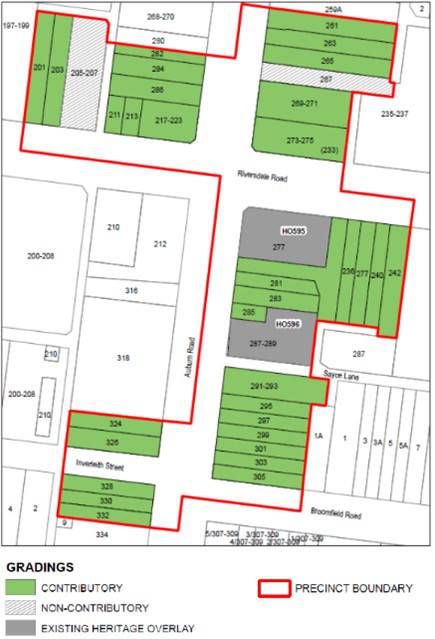| Back to search results » | Back to search page » |
|
Riversdale Village Precinct
LocationAuburn Road and Riversdale Road HAWTHORN, BOROONDARA CITY LevelIncluded in Heritage Overlay |
|
Statement of Significance
What is Significant?
The Riversdale Village Precinct, located at the intersection of
Auburn and Riversdale roads, Hawthorn. The precinct has a mixed
character created by the range of Victorian, Edwardian, and interwar
architectural styles, the single and double-storey built form of the
shops, and the one three-storey corner building (the Riversdale
Hotel). The precinct consists of nos. 261-305 on the east side of
Auburn Road, nos. 282-290 and 324-332 on the west side of Auburn Road,
nos. 201-233 on the north side of Riversdale Road, and nos. 234-242 on
the south side of Riversdale Road. The Italianate Riversdale Hotel at
277 Auburn Road and the Federation Free Style W.A. Carr's Butcher Shop
at 287-289A Auburn Road are individually significant buildings within
the precinct. No. 267 Auburn Road and nos. 205-207 Riversdale Road are
identified as non-contributory buildings within the precinct. The precinct was subdivided for commercial development from larger
estates from 1883. It was established and consolidated as a retail and
commercial centre over a fifty-year period from the 1880s into the
interwar period.
How is it significant?
The Riversdale Village Precinct is of local historic, architectural,
and aesthetic significance to the City of Boroondara.
Why is it significant?
Historically, the Riversdale Village Precinct is significant for its
ability to demonstrate the establishment and consolidation of one of
Hawthorn's commercial and retail centres at the intersection of
Riversdale and Auburn roads from the late 1880s into the interwar
period. The varied architectural styles reflect the precinct's
development over an approximately 50-year period. The southeast corner
of the intersection was the first to be developed and this is
reflected in the predominance of Victorian architectural styles in
this part of the precinct. Land for these shops was subdivided and
made available for sale in 1883. From this time, the area began its
development as a retail and commercial centre in response to the
extension of the railway to this area in 1882. Growth continued with
the establishment of the horse drawn tram in 1890 along Riversdale
Road, which terminated at Auburn Road. While Hawthorn's development,
like elsewhere, slowed during the economic depression of the 1890s,
the City of Hawthorn experienced a period of economic recovery and
suburban resurgence during the first decade of the new century. This
is reflected in the precinct's Edwardian-era shops, many of which are
elegantly designed and elaborately detailed. The northwest corner
consists of predominantly Interwar-era buildings, built in response to
a broader intensification of residential development in Hawthorn
through the interwar years, when remaining vacant land was taken up
during an intensive boom between 1910 and 1940. The greatest changes
were seen in the area south of Riversdale Road. (Criterion A) Architecturally, the buildings in the precinct are representative of
typical forms of Victorian, Edwardian, and interwar commercial/retail
buildings of suburban shopping strips prior to WWII, built to the
front and side boundaries, forming a continuous street wall and sense
of cohesion, with roofs hidden behind parapets. Set back from the
street and a more domestic-styled building, the single-storey shop at
no. 269 Auburn Road is unusual within the precinct. Its original, low
face brick fence on the street boundary responds to the building
design and helps to integrate the building into the otherwise
continuous street wall. The shops and hotel, which represent a range
of architectural styles, demonstrate features typical of the eras in
which they were designed, including: decorative parapets with
pediments and finials, and decorative mouldings and pilasters for
Victorian shops; symmetrical and asymmetrical designs and use of
contrasting materials for Edwardian shops; use of more restrained
detailing for interwar shops; timber-framed and glazed entry doors,
metal-framed shop windows with top-lights (some leadlight), recessed
entrances, panelled highlight windows above awnings. (Criterion D) Like other precincts in Boroondara, the precinct is characterised by
a range of architectural styles from the Victorian, Edwardian, and
interwar periods, and single and double-storey built form of the
shops; plus the three-storey Italianate Riversdale Hotel corner
building. While the overall precinct is characterized by its
diversity, development of some shop buildings as pairs and in larger
groupings of up to six shops contributes a sense of cohesion (in
addition to that noted above). While some original surfaces have been
overpainted, some awnings have been removed or replaced, and some
original shopfronts have been removed or altered (some
sympathetically), this does not adversely affect the aesthetic
character of the precinct. (Criterion D) Aesthetically, the precinct is distinguished from other precincts in
Boroondara by the relatively high proportion of intact high quality
upper-storey facades and intact and partially intact shopfronts.
(Criterion E) Aesthetically the precinct is also significant for its fine landmark
buildings, specifically the Italianate Riversdale Hotel at 277 Auburn
Road and the Federation Free Style W.A. Carr's Butcher Shop at
287-289A Auburn Road, both of which are locally significant places.
(Criterion E)
Group
Commercial
Category
Commercial Precinct






